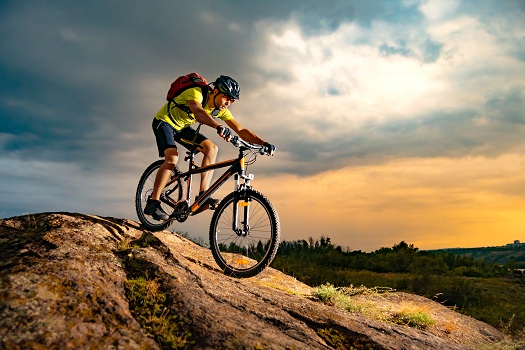As seasons change and the weather gets warmer, there’s still plenty to do at Mammoth Mountain. One of the popular warm-weather activities in this area is mountain biking. If this is one of your reasons for planning a trip to Mammoth Lakes, here are some important safety tips to remember to make your outdoor adventure even more enjoyable. If you need additional safety advice or equipment before you head up the mountain, stop in and see the friendly staff at ASO Mammoth, the one-stop shop for bike, snowboard, and ski rental Mammoth visitors trust for high-quality gear and premier service.
Check Your Helmet
No matter how experienced you are with mountain biking, you could sustain a serious head injury if your helmet doesn’t fit right. Try it on as you get your gear together to see if it’s still comfortable for you. Also, look for any signs of wear or damage.
Know Your Limits & Choose Appropriate Trails
You’re not going to do yourself any favors safety-wise if you choose trails that aren’t in line with your current capabilities. For instance, if you’re at the beginner or intermediate level, it’s best to stay away from the middle section of the Flow Trail—it’s called “The Drop” for a reason. Besides, you’ll still be treated to amazing views on the less challenging trails.
Run through Your Gear Checklist
You’ll be safer as you mountain bike if you have all the necessary gear with you. In addition to a helmet that fits properly, this list typically includes:
• Gloves to protect your hands and wrists
• Shoes that allow your feet to firmly fit on the pedals
• Goggles or protective glasses to shield your eyes from glare and debris
Depending on your preferred terrain, you may benefit from some additional gear for safety purposes. This list can include knee and elbow pads, padded shorts, and shin protection.
Double-Check Your Bike
A bike that’s not well maintained could increase your risk of having a serious accident, especially given the higher speeds associated with mountain biking. A routine bike check should include:
• Brakes
• Chain and chain rings—also check tightness and lubrication
• Handlebars and grips
• Tires, spokes, and the hub
Get the Seat Height Right
If the seat height is off, you’ll be less stable on your bike. On a bike you’ve ridden before, double-check the seat height to make sure it’s still at a level that allows you to properly ride. If you’ll be using a new bike, there are a few different ways to get an accurate seat height. One way is to measure your inseam and multiply it by 0.883. Another option is to measure the angle of your knee and ankle as you pedal.
Stay Hydrated
You can still become dehydrated while on the trails for long periods even if you’re not thirsty. Err on the side of caution and increase your personal safety at the same time by bringing water with you. A reusable bottle can easily fit into a lightweight backpack.
Carry a First Aid Kit
As long as we’re on the subject of backpacks, don’t forget a first aid kit. A small kit with the basics in it can come in handy if you experience falls or other injuries requiring immediate attention.
Bring a Friend or Let Others Know Where You’ll Be
Riding with a friend gives you access to an extra set of eyes and input from somebody you trust who can point out any risks you may not be aware of. If you opt to mountain bike alone, bring your phone or let someone know where you’ll be riding.
It’s time to grab your bike and hit the trails! Don’t let your trip be ruined by getting injured because you failed to use common sense and follow safety guidelines. If you need advice on Mammoth’s best trails, high-quality biking gear, or information about Mammoth snowboard rental, stop by ASO Mammoth. We have everything you need to make your biking experience a memory to treasure. Drop in or give us a call at 760-965-3444.

